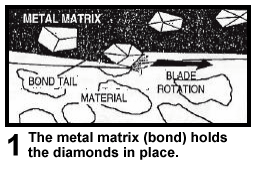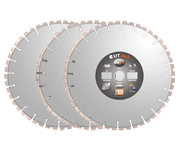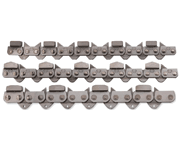Concrete Cutting Diamond Tools
Please call 800-882-4959
for help choosing
the perfect diamond blade, core bit, or chain.
the perfect diamond blade, core bit, or chain.
How Diamond Tools Work
 Diamond blades don't cut they grind! The exposed diamond
crystals do the grinding work. The metal matrix or bond holds
the diamonds in place. Trailing behind each exposed diamond is
a "bond tail" which helps to support the diamond. As the blade
rotates through the material the exposed surface diamonds grind.
Diamond blades don't cut they grind! The exposed diamond
crystals do the grinding work. The metal matrix or bond holds
the diamonds in place. Trailing behind each exposed diamond is
a "bond tail" which helps to support the diamond. As the blade
rotates through the material the exposed surface diamonds grind.After several thousand passes through the material being cut the exposed diamonds begin to crack and fracture. The matrix holding the diamond also begins to wear away.
Eventually the diamond completely breaks up and it's fragments are swept away with the material that it is grinding.
As the old diamonds are worn down they are replaced by new ones and the process continues until the blade is worn out.
Factors that effect performance
Compressive Strength:
| Concrete Hardness | PSI | Application |
| Critically Hard | 8,000+ | Nuclear Power Plants |
| Hard | 6-8,000 | Bridge Piers |
| Medium | 4-6,000 | Highways |
| Soft | 3,000 or less | Residential & Commercial Building |
Type of Sand:
Sand is the component of the mix which determines the
abrasiveness of the concrete. Sand can either be "sharp"
(abrasive) or "round" (non-abrasive). Crushed sand or bank
sand are usually sharp; river sand is usually round.
Size of Aggregate:
Larger aggregates tend to make a blade cut slower while smaller aggregates tend to allow a blade cut faster. The most common aggregate sizes are:
| Size | |
| Pea Gravel | Usually less than 3/8" in diameter |
| 3/4" | Sieved size |
| 1-1/2" | Sieved size |
Hardness of Aggregate:
There are many different types of rock used as aggregate.
Generally hard aggregate breaks down the cutting diamonds faster which means the bond must be softer to
expose new diamonds. Softer aggregate generally does
not break down the cutting diamonds as quickly and
therefore requires a harder bond to hold the diamonds in
place to use their full potential. The Mohs' scale is used to
estimate hardness:
| Moh's Range | Description | Aggregates |
| 8-9 | Critically Hard | Flint, Chert, Trap Rock |
| Basalt 6-7 |
Hard | River Rock, Granites, Quartz, Trap Rock |
| 4-5 | Medium Hard | Granites, River Rock |
| 3-4 | Medium | Limestone, Sandstone |
Reinforcing Steel:
Steel reinforcing tends to make a blade cut slower. Less reinforcing allows a blade to cut faster. Heavy rebar can also result from
different grades of steel. Typical rebar is grade 40 but grade
60 is also common. Rebar gauges are in eights of an inch. #4 is
1/2" diameter, #5 is 5/8" diameter etc.
| Size | Examples |
| Light | Wire mesh, single mat |
| Medium | #4 rebar every 12" on center each way (OCEW) single mat. Wiremesh multi-mat. |
| Heavy | #5 rebar 12" OCEW single mat #4 rebar 12" OCEW double mat |
Green or Cured Concrete:
The drying or curing of concrete greatly affects how the concrete
will interact with a diamond blade. Green concrete is freshly
poured concrete that has not yet cured. It is softer and more
abrasive than cured concrete. A harder bond with undercut
protection should be used in this application until it is cured
at which point a softer bond would be appropriate.The definition of green concrete can vary widley. Water, temperature,
moisture in the aggreagate, time of the year and the amount
of water in the mix all influence the curing time.
Variables:
Variables |
Change |
Results |
||
Cutting Speed |
Blade Life |
|||
The Blade |
Segment Bond Hardness | Harder | Slower |
Longer |
| Softer | Faster |
Shorter | ||
| Diamond Quality | Lower | Slower |
Longer | |
| Higher | Faster |
Shorter | ||
| Diamond Concentration | Lower | Slower |
Longer | |
| Higher | Faster |
Shorter | ||
| Segment Width | Thicker | Slower |
Longer | |
| Thinner | Faster |
Shorter | ||
The Saw |
HorsePower | Lower | Slower |
Longer |
| Higher | Faster |
Shorter | ||
| Blade Speed | Higher | Slower |
Longer | |
| Lower | Faster |
Shorter | ||
The Job |
Water Volume | Higher | Slower |
Longer |
| Lower | Faster |
Shorter | ||
| Cutting Depth | Deep | Slower |
Longer | |
| Shallow | Faster |
Shorter | ||
| Cutting Pressure | Lower | Slower |
Longer | |
| Higher | Faster |
Shorter | ||
The Material |
Material Hardness | Harder | Slower |
Longer |
| Softer | Faster |
Shorter | ||
| Material Abrasiveness | Less | Slower |
Longer | |
| More | Faster |
Shorter | ||
| Aggregate Size | Larger | Slower |
Longer | |
| Smaller | Faster |
Shorter | ||
| Aggregate Amount | More | Slower |
Longer | |
| Less | Faster |
Shorter | ||




 Pro Cutters Guide
Pro Cutters Guide